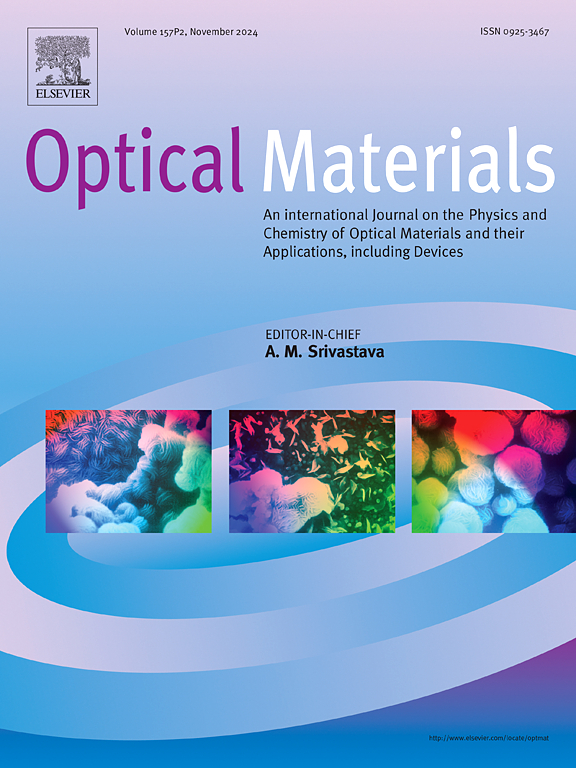Effect of selenium doping on the deposition and properties of cadmium sulfide thin films grown by a chemical bath deposition technique
IF 3.8
3区 材料科学
Q2 MATERIALS SCIENCE, MULTIDISCIPLINARY
引用次数: 0
Abstract
The present study highlights the changes in various physical properties of cadmium sulfide (CdS) thin films induced by doping with the chalcogenide ion Se. The films were obtained by a chemical bath deposition technique at low temperature, good quality thin films were synthesized, with the advantage of doping in-synthesis without the need for additional step. The structural analysis was carried out using grazing incidence X-ray diffraction, revealing that the incorporation of selenium led to the formation of two crystalline phases of CdS and CdSe, and a decrease in their crystallite size. The transmittance spectrum shows that the added selenium shifts the transmission region to higher wavelengths and reduces the transmittance. The films composition was determined by wavelength-dispersive X-ray fluorescence, revealing a lower fraction of selenium in the films than in the bath solution. By the oscillations in transmittance the film thicknesses were estimated, and it was found that they are reduced by the incorporation of selenium, this is in accordance with the decrease of the intensity of the X-ray diffraction and X-ray fluorescence peaks. The photoluminescence study shows that the higher energy emissions (close to 2.0 and 2.2 eV) are reduced and eliminated with the incorporation of Se into the material. This is attributed to shallow electron traps induced by the metal ion selenium. The characterization of the films indicates that incorporating selenourea into the chemical bath, using the specified working conditions, modifies the film deposition process and results in a red-shift of the absorption region.
硒掺杂对化学浴沉积法制备硫化镉薄膜沉积及性能的影响
本研究重点研究了硫系离子硒对硫化镉薄膜各种物理性能的影响。采用化学浴沉积技术在低温条件下获得薄膜,制备出了质量良好的薄膜,并具有在合成过程中掺杂而不需要额外步骤的优点。利用掠入射x射线衍射进行结构分析,发现硒的掺入导致CdS和CdSe两种晶相的形成,并使其晶粒尺寸减小。透射光谱表明,硒的加入使透射区向更高波长偏移,降低了透射率。通过波长色散x射线荧光测定了薄膜的组成,发现薄膜中的硒含量低于浴液中的硒含量。通过透射率的振荡估计薄膜厚度,发现硒的掺入使薄膜厚度减小,这与x射线衍射峰和x射线荧光峰强度的减小是一致的。光致发光研究表明,Se的加入降低并消除了材料中接近2.0和2.2 eV的高能量发射。这是由于金属离子硒引起的浅层电子陷阱。薄膜的表征表明,在规定的工作条件下,将硒脲加入化学浴中,改变了薄膜的沉积过程,并导致吸收区出现红移。
本文章由计算机程序翻译,如有差异,请以英文原文为准。
求助全文
约1分钟内获得全文
求助全文
来源期刊

Optical Materials
工程技术-材料科学:综合
CiteScore
6.60
自引率
12.80%
发文量
1265
审稿时长
38 days
期刊介绍:
Optical Materials has an open access mirror journal Optical Materials: X, sharing the same aims and scope, editorial team, submission system and rigorous peer review.
The purpose of Optical Materials is to provide a means of communication and technology transfer between researchers who are interested in materials for potential device applications. The journal publishes original papers and review articles on the design, synthesis, characterisation and applications of optical materials.
OPTICAL MATERIALS focuses on:
• Optical Properties of Material Systems;
• The Materials Aspects of Optical Phenomena;
• The Materials Aspects of Devices and Applications.
Authors can submit separate research elements describing their data to Data in Brief and methods to Methods X.
 求助内容:
求助内容: 应助结果提醒方式:
应助结果提醒方式:


